
The foot-in-the-door (FITD) technique leverages a simple but effective psychological principle: once people agree to a small request, they’re more likely to say “yes” to a larger, related request in the future.
This approach taps into our natural tendency to stay consistent with our previous actions and decisions and is successful because it makes the progression of requests feel gradual and logical.
But how does this tie into your website’s conversions and customer journey? Think about the typical visitor experience. Asking for a major commitment upfront—like purchasing a product or booking a demo—can feel like too much too soon. The FITD technique solves this by breaking down the journey into smaller, manageable steps that build trust and engagement.
A small “yes,” such as downloading a resource or signing up for a newsletter, becomes the gateway to larger actions like making a purchase or scheduling a call.By starting small, the technique avoids overwhelming or alienating individuals, instead building a sense of involvement step by step.
Continue in this article to see how FITD can take your conversions to the next level, with increased engagement and customer loyalty. At the end we’ll present real case applications of this technique in different industries. You don’t want to miss it 😉
Table of Contents
The Psychology Behind the Foot-in-the-Door Technique
When we make even a minor commitment, such as saying “yes” to something low-stakes, it subtly shapes our perception of ourselves as supportive or interested in that topic or cause. As a result, agreeing to larger requests aligned with that initial action feels like a natural next step.
This technique has been applied in various scenarios outside of marketing and sales, from public service campaigns to charity drives. For instance, if someone agrees to sign a petition supporting a cause, they’re more likely to donate to that cause later.
FITD is a cumulative process that fosters comfort and trust, as each minor agreement makes people more comfortable with the idea of doing something more significant down the line. This is why the foot-in-the-door technique remains one of the most enduring methods for engaging and gradually winning over individuals in various contexts.
How the Foot-in-the-Door Technique Translates to Digital Marketing
The foot-in-the-door technique has evolved from traditional sales tactics into a nuanced strategy in digital marketing, tailored to the unique dynamics of online customer journeys. Originally, FITD was a straightforward concept: ask for a small commitment to set the stage for a larger one.
In digital marketing, however, FITD has adapted to address the complexity of user behavior, where attention spans are shorter and customers are more selective about what they engage with.
Marketers use FITD to move users through a gradual process of engagement, recognizing that online audiences are less likely to commit immediately. This technique acknowledges that an initial, small interaction can create a psychological foundation that makes users more open to deeper levels of engagement over time.
Digital marketing strategies using FITD focus on building an authentic connection with users, one small interaction at a time. Each step is carefully calibrated to build trust and familiarity, making each “yes” feel like a logical continuation rather than a leap. It’s an approach that respects the user’s pace, fostering a series of micro-commitments that pave the way for more significant actions.
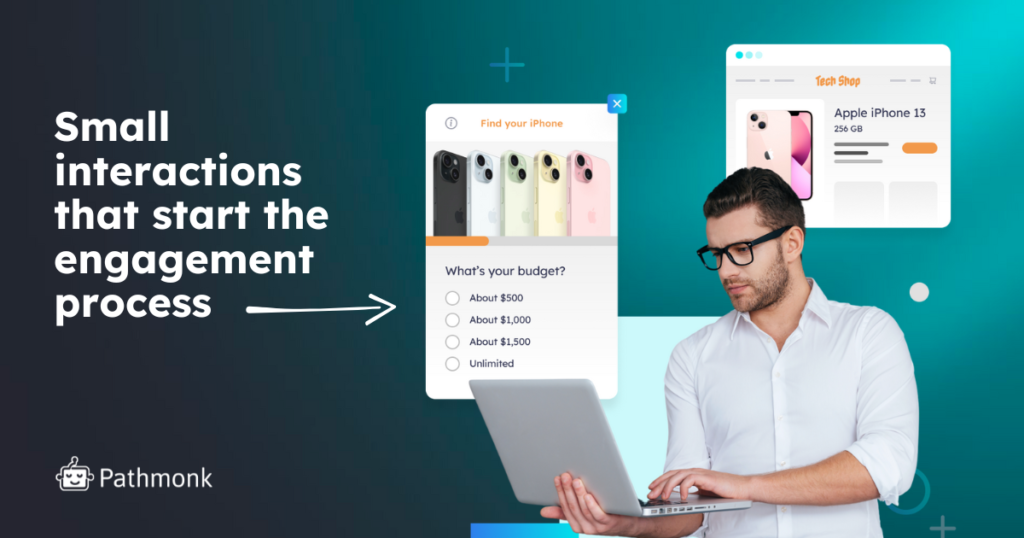
Benefits of FITD in Conversion Rate Optimization
Here’s how this technique directly impacts your conversion rates:
- Builds incremental trust: Starting with low-barrier requests establishes trust step-by-step, making users more likely to take the final action, whether it’s signing up, downloading, or purchasing.
- Reduces drop-off rates: With small initial asks, FITD lowers the perceived commitment level, reducing the risk of users leaving the page prematurely.
- Increases engagement with progressive micro-conversions: Each small “yes” can be seen as a micro-conversion, leading users from one action to the next. This layered engagement approach naturally propels them toward the ultimate conversion goal.
- Improves user journey flow: FITD creates a natural progression in the user journey, leading to an experience that feels organic and personalized. This flow encourages users to stay on the site longer, which improves CRO metrics.
- Optimizes for long-term retention and loyalty: Each step in the FITD approach fosters a sense of involvement with the brand, creating loyalty that extends beyond a single conversion and setting the stage for repeat interactions.
- Aligns with user expectations for a non-aggressive conversion process: FITD’s gentle approach meets modern consumer expectations, supporting CRO by creating a less aggressive path to conversion that respects user autonomy and choice.
Using FITD as part of your CRO strategy establishes a structured, low-pressure path that brings users closer to conversion naturally. By making the process feel progressive and comfortable, it maximizes conversion opportunities at every step of the journey.
Using FITD in Different Stages of the Customer Journey
By tailoring “small asks” to match the user’s current level of interest and readiness, marketers can nurture visitors from initial awareness to final decision without overwhelming them.
Awareness stage: introducing the brand with low-commitment interactions
At the awareness stage, users are often exploring options and are not yet ready to make significant commitments. Small, low-barrier asks work best here, as they invite users to engage without requiring a large investment of time or information.
- Content previews and blog articles: Offering valuable content, such as blog posts or introductory articles, allows visitors to explore the brand’s expertise at their own pace. This “soft entry” encourages engagement while building brand familiarity.
- Introductory videos: Short, informative videos can quickly convey the brand’s message and value, engaging users visually and making it easy to take that first step of engagement.
Social media engagement: Asking users to follow, like, or share content on social media is a small commitment that helps spread awareness while providing a low-friction way to stay connected.
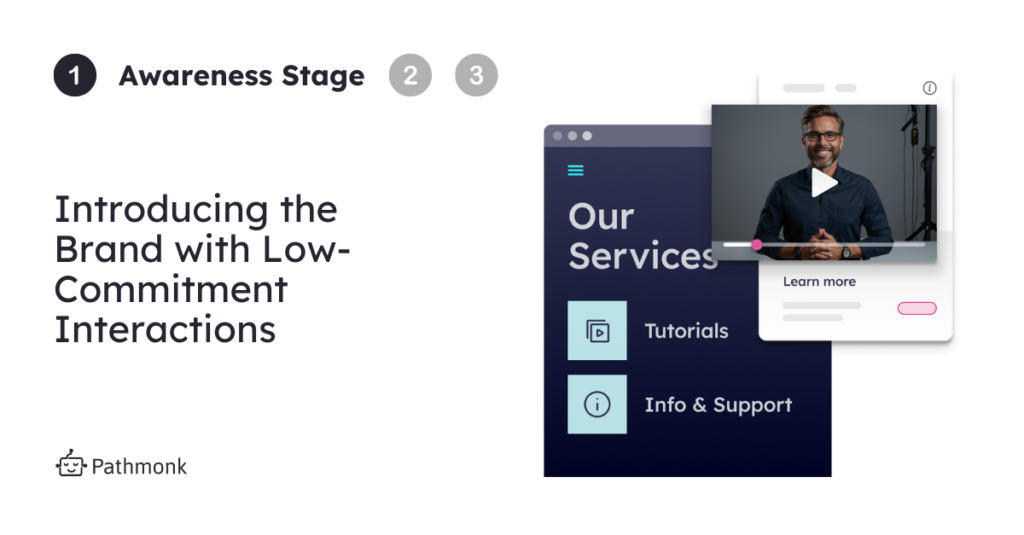
Consideration stage: building trust through incremental engagement
In the consideration stage, users have shown interest and are evaluating options. Here, slightly more involved interactions help deepen the relationship by offering value and encouraging exploration of the brand’s offerings.
- Content downloads: Offering downloadable resources, such as eBooks, guides, or white papers, is a moderate ask that gives users valuable information while creating a sense of investment.
- Webinars and product demos: Inviting users to attend a webinar or view a product demo lets them experience the brand’s value firsthand. These moderate interactions build familiarity without the pressure of an immediate purchase.
- Case studies and testimonials: Displaying social proof through case studies or testimonials allows users to envision the brand’s impact, encouraging them to explore further without making a high-stakes commitment.
These engagements create an incremental pathway to the next stage. By providing useful information and experiences, brands increase users’ comfort and trust, making them more likely to progress toward a decision.
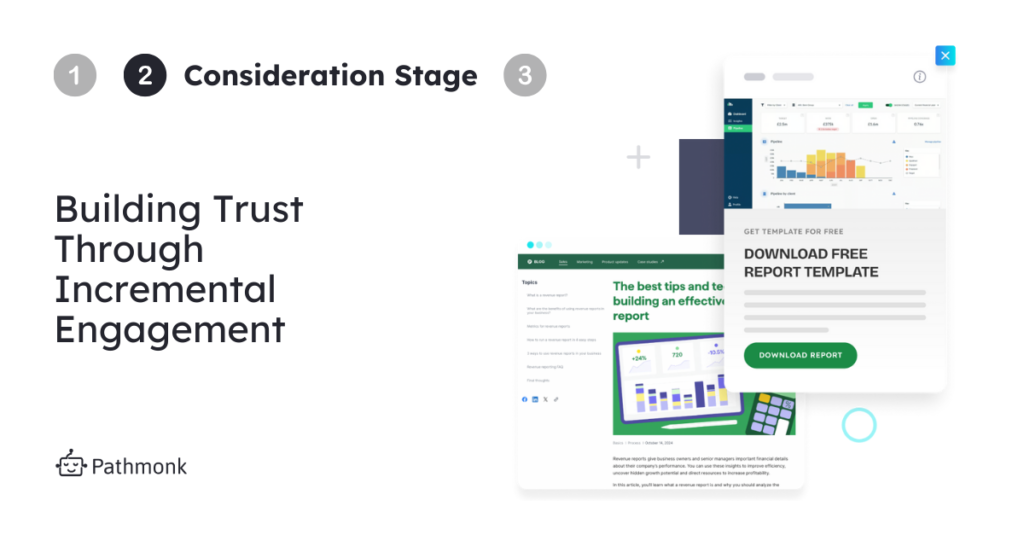
Decision stage: encouraging the final conversion with tailored offers
At the decision stage, users are close to making a commitment, and the FITD approach shifts to focus on easing the final step. Here, small asks center on nudging users to take action without overwhelming them, often through personalized or time-sensitive incentives.
- Free trials or initial discounts: Offering a free trial or first-time discount is a low-risk way for users to experience the product. This small commitment lowers barriers and provides a final nudge toward purchase.
- One-click demo requests: Simplifying the request for a live demo or consultation makes the final step effortless, allowing users to commit with minimal friction.
- Personalized recommendations and reminders: Dynamic, tailored recommendations or gentle reminders encourage users to make the final decision, making them feel understood and supported in their purchase journey.
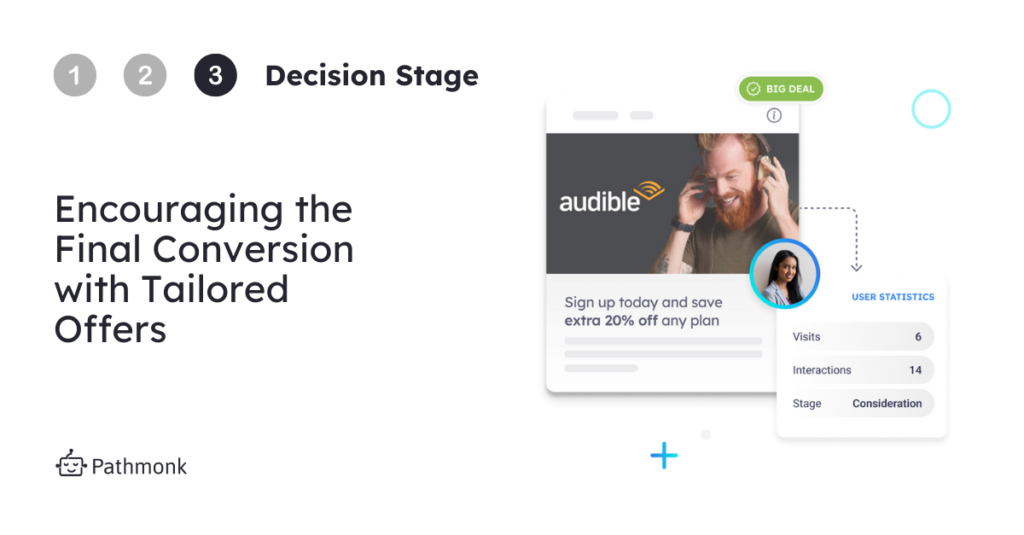
By gradually increasing the commitment level across each stage, the FITD approach nurtures users along a path to conversion. The technique respects the user’s readiness at each step, leading to a final decision that feels natural and positive.
Examples of the Foot-in-the-Door Technique in Action
Implementing FITD technique has proven effective across various industries by guiding users through incremental engagements that build trust and lead to higher conversion rates. Below are examples of how this approach has been successfully applied.
Be Fit South Shore | health & fitness – boosted 54% in trial bookings
Be Fit South Shore faced low conversion rates, with potential clients visiting their website but not committing to trial bookings. To address this, Be Fit South Shore integrated Pathmonk’s AI-driven personalization into their website. This approach included:
- Introduction videos: At the awareness stage, engaging videos created by team members were introduced to quickly communicate the value proposition and establish a connection with visitors.
- Showcasing reviews and case studies: During the consideration phase, the website featured reviews and testimonials from satisfied customers, building trust and credibility through social proof.
- One-click VIP signup: At the decision stage, a streamlined signup process was implemented, making it easy for visitors to book a VIP trial with a single click.
FITD application: This strategy exemplifies the FITD technique by starting with low-commitment interactions, such as watching a brief video, and gradually guiding users toward booking a trial. Each step builds on the previous one, fostering a sense of commitment and making the final action feel like a natural progression.
Result: This approach led to a 54% increase in trial bookings, demonstrating the effectiveness of incremental engagement in converting website visitors into clients.
Thrive Learning | education & training – 117 high-ticket leads acquired
Thrive Learning aimed to increase both the quantity and quality of its demo bookings, particularly targeting high-ticket clients. Despite substantial website traffic, previous conversion strategies had not delivered the expected return on investment. Thrive Learning integrated Pathmonk into their website, focusing on providing tailored content and experiences at various stages of the user’s buying journey. This included:
- Introduction videos: Used at the awareness stage to quickly communicate the value proposition and establish a connection.
- Showcasing reviews and case studies: Featured during the consideration phase to build trust and credibility through social proof.
- One-click demo booking: Implemented at the decision stage to streamline the demo booking process, making it easy for visitors to take action.
FITD application: By initiating engagement with low-barrier actions like watching a video or reading a testimonial, Thrive Learning gradually built trust and guided users toward booking a demo. This step-by-step approach aligns with the FITD technique, easing users into larger commitments.
Result: This strategy resulted in 117 high-ticket leads, highlighting the power of incremental engagement in attracting qualified prospects for premium offerings.

SmarterStore | e-Commerce – increased conversions through enhanced engagement
SmarterStore, an Italian e-commerce company specializing in mobile phones and hi-tech accessories, faced low sales due to customer decision fatigue. Visitors often experienced prolonged decision-making times, negatively impacting conversion rates. Integrating Pathmonk on their website played a pivotal role in enhancing user engagement and driving conversions. The solution included:
- Introduction videos at the awareness stage: Engaging videos were used to quickly communicate the value proposition and create an instant connection with visitors.
- Reviews and case studies during the consideration phase: The website highlighted external reviews and product feedback to build trust and credibility.
- Custom qualification form at purchase: A custom-designed qualification form guided users through a series of curated questions about their desired phone features, simplifying the decision-making process and encouraging them to proceed with their purchase.
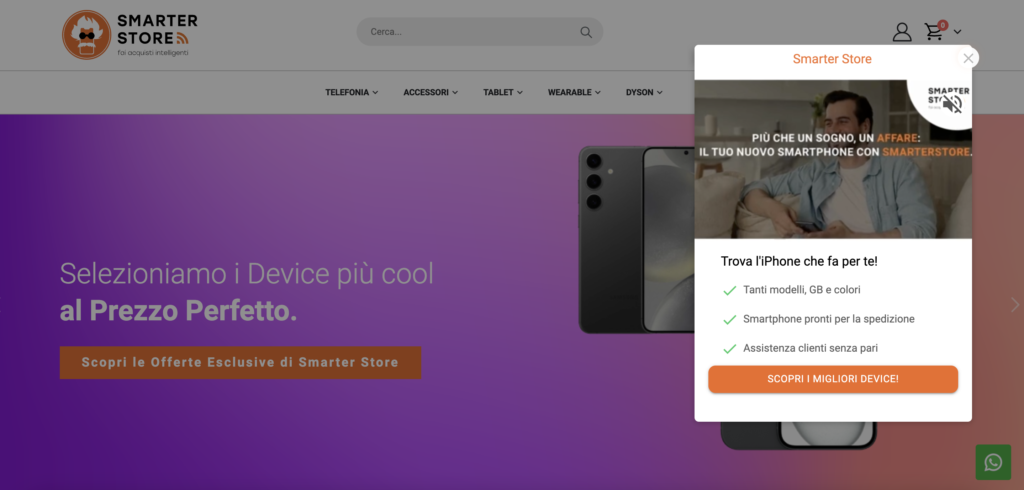
FITD application: By starting with engaging content and gradually introducing more personalized interactions, SmarterStore reduced decision fatigue and guided users toward making a purchase. This incremental approach reflects the FITD technique, easing users into the buying process.
Result: This strategy led to a 178% increase in purchases, demonstrating the effectiveness of the FITD approach in reducing decision fatigue and boosting sales in the e-commerce sector.
More Conversions with Automated Foot-in-the-Door
What’s the real secret to unlocking sky-high conversions on your website? It’s all about drawing visitors in and guiding them, step-by-step, toward that final “yes”. That’s where the FITD technique truly shines—especially when it’s powered by automation.
Pathmonk takes the FITD approach to a new level by leveraging AI to deliver personalized interactions that match each visitor’s stage in the customer journey. Imagine a solution that dynamically adapts to user behavior, inviting visitors to take that first small step—whether it’s exploring a piece of content, signing up for a guide, or discovering a product demo.
This AI-driven engagement can boost conversions by up to 8x, with average gains of around 50%. Ready to see how this could work for you?
- Experience Pathmonk’s capabilities first-hand in this personalized demo, no sales calls required;
- Or book a product tour with our team for a more detailed experience.
With Pathmonk, you have the automated power to make every step matter—one small commitment at a time.





